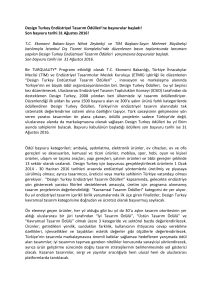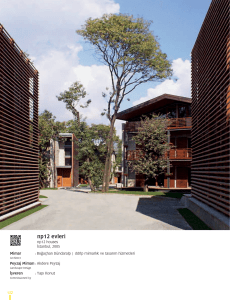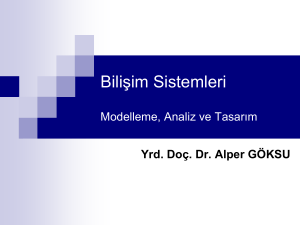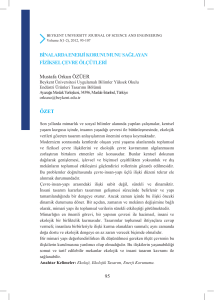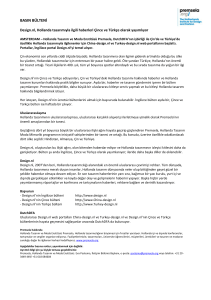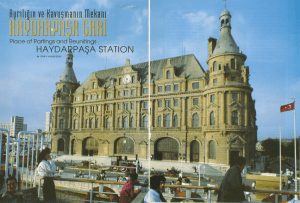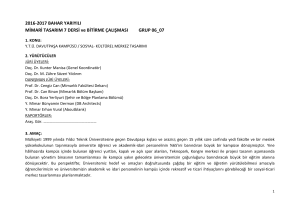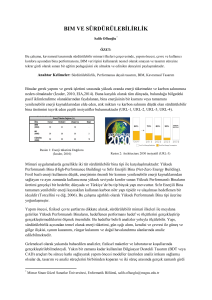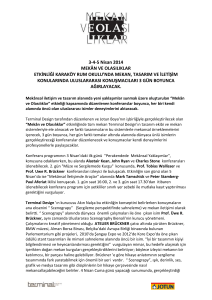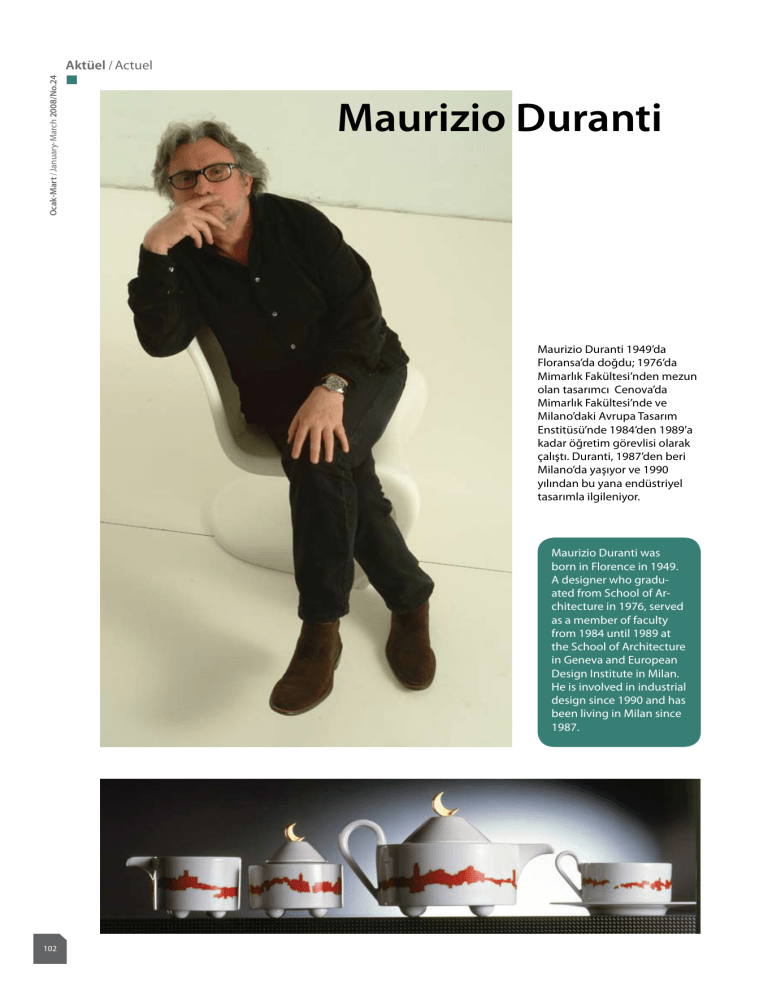
Ocak-Mart / January-March 2008/No.24
Aktüel / Actuel
Maurizio Duranti
Maurizio Duranti 1949’da
Floransa’da doğdu; 1976’da
Mimarlık Fakültesi’nden mezun
olan tasarımcı Cenova’da
Mimarlık Fakültesi’nde ve
Milano’daki Avrupa Tasarım
Enstitüsü’nde 1984’den 1989’a
kadar öğretim görevlisi olarak
çalıştı. Duranti, 1987’den beri
Milano’da yaşıyor ve 1990
yılından bu yana endüstriyel
tasarımla ilgileniyor.
Maurizio Duranti was
born in Florence in 1949.
A designer who graduated from School of Architecture in 1976, served
as a member of faculty
from 1984 until 1989 at
the School of Architecture
in Geneva and European
Design Institute in Milan.
He is involved in industrial
design since 1990 and has
been living in Milan since
1987.
102
Duranti’nin çalışmaları arasında; yenilikçi özellikleri dolayısıyla ulusal ve yabancı basında
sıklıkla yayımlanmış olan binaların plan ve
projeleri, sergi standları ve showroom’ların
yerleşimleri var. Tasarımcı, 1990’dan beri
çabalarını endüstriyel tasarıma yoğunlaştırmış
olup; her türlü hammadde ve üretim teknolojilerini kullanarak önde gelen evde kullanılan
ürün imalatçıları için çok sayıda başarılı ürün
yaratmıştır.
1996, ‘97, ‘98, 2003 ve 2005’te ABD’de İYİ TASARIM ÖDÜLLERİ’nde başarı kazanmış ve 1998’de
“18. Milano Altın Pusula Ödülü” verilerek onore
edilmiştir.
Kendisinin tasarladığı çok sayıda ürün, tüm
dünyadaki Chicago’da Athenaeum, Tokyo
Bunkamura Tasarım Koleksiyonu, Monaco
Baviera Neue Samlung Müzesi, Gent Tasarım ve
Dekoratif Sanatlar Müzesi, Londra’da Victoria
& Albert Müzesi gibi tanınmış müzelerin kalıcı
koleksiyonlarında bulunmaktadır. Ulusal ve
dış basında eserleri ile ilgili olarak yayımlanan
makaleler yanında, hakkında kitaplar da
yazılmıştır. “Maurizio Duranti, Design Adventures”, D.Baroni, Agepe 1991 and “Maurizio
Duranti, Designs and Design”, D.Baroni, I MENIR
series, Ed. L’Archivolto, 1993.
Kişisel sergilerinden bazıları: “Handy Articles in
Wood and Ceramic” (Milan 1988), “The Mediterranean Home” (Bologna 1991), “Adventure Planning” (Bologna 1991), “La stanza della sposa” (Bologna 1991), “Household Rituals” Milan 1992 and
Among his realisations are the planning and design of building structures,
the fitting out of exhibition stands and
showrooms which have frequently
been published by the national and
foreign press for their innovative features. Since 1990 he has concentrated
his efforts on industrial design and has
created many successful products for
leading manufacturers of household
products adopting all types of raw
materials and productive technology.
In 1996, ‘97, ‘98, 2003 and 2005, he
received acknowledgements at the
GOOD DESIGN AWARD in the U.S.A.
and was honoured at the award giving
of the “18th Gold Compass of Milan” in
1998.
Numerous products designed by him
are present in permanent collections
of well-known museums throughout
103
Ocak-Mart / January-March 2008/No.24
Aktüel / Actuel
the world: Athenaeum in Chicago, Bunkamura Design Collection of Tokio, Neue Samlung Museum of
Monaco Baviera, Museum of Design and Decorative
Arts of Gent, Victoria & Albert Museum in London.
As well as many articles published on his works by
the national and foreign press, his monographs
have also been edited: “Maurizio Duranti, Design
Adventures”, D.Baroni, Agepe 1991 and “Maurizio
Duranti, Designs and Design”, D.Baroni, I MENIR
series, Ed. L’Archivolto, 1993.
Frankfurt 1993), Going Home (San Francisco, Houston
1993), Abitare il Tempo (Verona, quasi tutte le edizioni), Good Design (Chicago ‘96, ‘97, ‘98-2003). Kendisi
ayrıca İtalya, Almanya, A.B.D., Japonya, Kore, Avustralya,
İspanya ve Belçika’da çeşitli ortak sergilere katılmıştır.
Üretim prosesleri ve hammaddelerin fiziksel olanakları
üzerinde derin bilgiye sahip olsa da; teknoloji yerine
anlatıcı görüntü türlerini yeğleyen Duranti’nin eserleri
günlük yaşam ile yarışan ironilerle dolu.
Vitrifiye sektörünün öncü firmalarından Çanakcılar
Seramik’in Ceravit markası için Slim Line banyo serisinin tasarlayan Duranti, yarattığı seri için; çok sade,
şık, çarpıcı ve ince hatlara sahip bir tasarım diyor.
Slim’de ortaya koymak istediğinin herkes tarafından
anlaşılabilecek çok basit bir şey yapmak olduğunu
söyleyen tasarımcı, Slim’i sadece Türkiye’de satılması
için yapmadığını, evrensel bir ürün yaratmaya
çalıştığını belirtiyor. ‘Bir tasarımcı için önemli olan
üretim aşamasıdır ve üreticinin tasarımcıyı anlamasıdır’
diyen Duranti, Creavit’te bunu bulduğunu ve geleceğe
dair birliktelik kararı alınırsa Creavit felsefesi ile Maurizio Duranti felsefesinin kesiştiği noktaların artacağını
ve yeni koleksiyonların hayata geçirileceğini belirtiyor.
104
Of his personal exhibitions we recollect: “Handy
Articles in Wood and Ceramic” (Milan 1988), “The
Mediterranean Home” (Bologna 1991), “Adventure
Planning” (Bologna 1991), “La stanza della sposa”
(Bologna 1991), “Household Rituals” Milan 1992 and
Frankfurt 1993), Going Home (San Francisco, Houston 1993), Abitare il Tempo (Verona, quasi tutte le
edizioni), Good Design (Chicago ‘96, ‘97, ‘98 e 2003).
He has also participated in several joint exhibitions
in Italy, Germany, U.S.A., Japan, Korea, Australia,
Spain and Belgium. His creations narrate imaginary
stories and are full of irony which compete with
everyday life. Although he has profound knowledge
of productive work processes and the physical possibilities of raw materials, instead of technology he
favours a narrative type of image.
Duranti, who designed the Slim Line bathroom line
for Creavit brand for one of the leading firms in the
vitreous ware sector, Çanakcılar Seramik, describes
the series he created a design very plain, elegant,
striking, having fine lines. The designer, who states
that what he seeks to present with Slim is to create
a very simple thing which can be understood by everyone, says he did not create Slim just to be sold in
Turkey, but that he attempted to generate a universal product. Duranti, who says, ‘What is important
for a designer is the production stage and the producer’s understanding the designer’, adds that he
found this with Creavit and in case of collaboration
in the future, the points where the Creavit philosophy and Maurizio Duranti philosophy intersect will
increase and new collections will be launched.
�����������������
���������������������
����������������
����������������������
����������������
��������������������������������
�������� ��� ���� ����������
������������������������������������
����� �� ������� ��� ��������
�����������������������������
����������
������������������������������
������������������������������
���������������������������������
���������������������������������
��������������������������������
�����������������
�����������
��������
�����������
������������������������
���
������������������������
������������������������
�����������������������������
�����������������������
������
����������������������
��������������������������
������������
Ocak-Mart / January-March 2008/No.24
Aktüel / Actuel
Haydarpaşa Garı
Haydarpaşa Central Station
İstanbul’un Anadolu ve Ortadoğu’ya açılan ilk
kapısı (garı) olan Haydarpaşa Gar Binası inşaatına
devrin Osmanlı padişahı II. Abdülhamit (1842-1918)
döneminde 30 Mayıs 1906 tarihinde başlanmış ve
19 Ağustos 1908’de tamamlanarak hizmete girmiştir.
Binanın bulunduğu sahaya Selimiye Kışlası’nın
yapımında büyük emeği geçen Padişah III. Selim’in
paşalarından Haydar Paşa’nın adı verilmiş ve bundan
sonra bu yere yapılan bina da bu adla anılagelmiştir.
Binanın inşaatı ‘Anadolu- Bağdat Şirketi’ adı altındaki
bir Alman şirketi tarafından gerçekleştirilmiş; ayrıca
Şirketin Genel Müdürü Bay Hünken’in teşebbüsü ile
garın önüne bir mendirek inşa edilmiş, Anadolu’dan
gelen ve Anadolu’ya gidecek vagonlar için ticari eşya
yükleme ve boşaltma tesisleri ve silolar yapılmıştır.
Binanın mimari proje etüd safhasında çok çeşitli
etüdler yapılmış, ancak iki Alman mimarı olan Otto
Ritter ve Helmuth Conu tarafından hazırlanan proje
yürürlüğe girmiştir. Binanın inşaatında Alman ustalarla
birlikte İtalyan taş ustaları da çalışmıştır.
Gar binası başlangıçta 2.525 m² alana kurulmuş
ve bugünkü kapalı kısımları ile birlikte 3836 m²’lik
bir alana yayılmıştır. Gar, özellikle binasının mimari
özellikleriyle muhteşem bir sanat eseridir. Gar binası,
Orta Avrupa Barok, Alman Rönesans ve Neo-Klasik
mimarî örneklerinden izler barındırmaktadır. Her biri
21 metre uzunluğunda 1.100 adet suya karşı dayanıklı
ahşap kazık üzerine inşa edilmiş ve bu kazıklar
buharlı şahmerdan ile çakılmıştır. İnşaatta 2.500 m³
lefke taşı, 13.000 m³ beton, 1.140 ton demir, 500 m³
kereste, 19.000 mt sert ağaç ve 6.200 m² arduvaz çatı
kaplaması kullanılmıştır. Binanın çatısı ahşap olup
106
The construction of Haydarpaşa Central
Station building, which was Istanbul’s first
gate opening to Anatolia and the Middle East,
was started on May 30, 1906 during the reign
of Ottoman Sultan Abdülhamit II (1842-1918)
and was completed and launched on August
19, 1908. The name of Haydar Paşa (Haydar
Pasha), one of Sultan Selim II’s pashas who
had major contributions to the construction of
Selimiye Barracks, was given to the area where
the building is located; hence the building
constructed in the area has started to be called
by that name.
The construction of the building was carried
out by a German company named ‘AnatoliaBaghdad Company’; a breakwater was built
in front of the station with the initiative of Mr.
Hünken, General Manager of the company, and
also commercial cargo loading and unloading
facilities and silos were built for wagons coming
from and going to Anatolia.
A large number of surveys were done during
the architectural design survey phase of the
building and eventually the plan prepared by
two German architects, Otto Ritter and Helmuth
Conu, being chosen.
Italian masons have worked in the construction
of the building alongside of German craftsmen.
In the beginning, the central station building
was installed on an area of 2,525 m2, spreading
Alman mimarisinde çok kullanılan dik çatı şeklindedir.
Güney cephesinin çatı hizasında yer alan barok düzenli
alınlıkta büyük bir saat yer almaktadır. Tekerlekli
kartal kanadı ile süslü olan saatin kadranı, Alman
Demiryolları’nın simgesi olarak bilinir. Bu motif, daha
sonraları ölçümlenerek Türk Demiryolları’nın da simgesi
olarak kabul edilmiş.
I. Dünya Savaşı’nda Anadolu’ya sevk edilmek üzere
gar binasında depolanan cephaneler 1917 tarihinde
yapılan bir sabotaj sonucu infilak ederek büyük bir
yangın çıkarmıştır. Gar binası yangını ile birlikte garda
harekete hazır bekleyen ve gara girmekte olan cephane
ve asker dolu çok sayıda vagon da bu arada yok olmuş,
binanın çatısı imha olmuş ve diğer bölümleri de hasara
uğramıştır.
Akabinde yapılan bazı onarım ve değişikliklerle gar
binası ve çatısı bugünkü görünümünü almıştır. 1979
tarihinde ise Haydarpaşa mendireğinin biraz açığında
akaryakıt yüklü “Independenta” adlı tankerin bir başka
gemi ile çarpışması sonucu meydana gelen patlamada
O. Linnemann tarafından gerçekleştirilmiş olan çok
değerli kurşunlu vitraylar hasara uğramış ve bu
olaydan sonra pencereler derhal aslına uygun olarak
onarılmıştır.
Hizmete açıldığından beri çok büyük çapta bir
restorasyon geçirmemiş olan gar binası Türkiye
Cumhuriyeti Devlet Demiryolları (TCDD) yetkililerince
eski eseri koruma ve kurtarma çabasında gösterdikleri
teşebbüs sonucu 1976 yılında geniş çapta onarıma
alınarak, 1983 yılı sonunda dört dış cephe ile iki kulenin
restorasyonu tamamlanmıştır.
over 3,836 m2 over its present covered sections.
The station is a magnificent work of art
especially thanks to the architectural features
of the building. The station building bears
traces from Central European Baroque, German
Renaissance and Neo-Classical architecture. It
was built on 1,100 waterproof wooden piers
each 21 meters long; these piers were driven
by a steam jackhammer. 2,500 m³ lefke stone,
13,000 m³ concrete, 1,140 tons steel, 500 m³
wood, 19,000 mt hard wood and 6,200 m² slate
roofing were used in the construction. The roof
of the building is wood in the form of vertical
roof, largely used in German architecture. There
is a large clock on the baroque style fronton
aligned with the roof of the southern façade.
The dial of the clock decorated with a wheeled
eagle wing is known as the symbol of German
Railways. This motif was subsequently measured
and accepted as the symbol of Turkish Railways
as well.
The ammunition stored at the railway station to
be shipped to Anatolia in World War I exploded,
leading to a big fire as a result of sabotage
in 1917. In the fire, many wagons waiting for
departure at the station and entering the station
full of ammunition and soldiers were destroyed
together with the roof of the building and other
parts of the building were damaged.
With certain repairs and changes made
thereafter, the station building and its roof
has gained its present look. In the explosion
which took place in 1979 due to a collision of a
tanker named “Independenta” carrying oil off
Haydarpaşa breakwater, highly valuable lead
stained glasses, the works of O. Linnemann, were
damaged and the windows were immediately
repaired true to their original form after this
incident.
The central station building, which has not gone
through a major restoration since its launch,
was placed under a major overhaul in 1976,
thanks to the initiative of Republic of Turkey
State Railways Authority (TCDD ) officials, as part
of their efforts in the field of conservation and
recovery of historical works, and the restoration
of the four exterior façades and two towers was
completed at the end of 1983.
107



